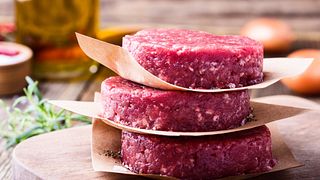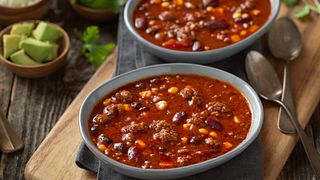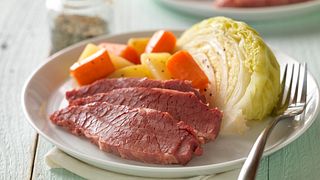An Overview of Ground Beef at Retail and Foodservice
September 29, 2021
While the beef industry offers consumers many choices when it comes to items in the meat case or options on a menu, one beef product remains the overwhelming leader. From January through July of this year, Ground Beef products have comprised 49% of retail sales in the U.S. in terms of volume and 37% of dollars.1 Consumers see Ground Beef as a versatile, affordable, and frequent meal option. According to the Beef Checkoff-funded Consumer Beef Tracker, nearly 60% of consumers eat Ground Beef as an ingredient and over 50% consume a hamburger at least weekly.2 There is no doubt shoppers demand a wide variety of options when it comes to food purchases, and Ground Beef rises to this challenge. Whether it is the form of the product, production-based claims, or the lean-to-fat ratio, Ground Beef allows consumers to choose products that fit their preference.
Due to an increase of consumer traffic resulting from pandemic dynamics, Ground Beef had a tremendous year at the retail level. Popular for its recipe versatility and ability to be frozen, Ground Beef saw an additional $2.05 billion in dollars sold at retail, totaling $12.4 billion for 2020.3 During the initial “stock-up” phase of the pandemic, Ground Beef was a key item that consumers desired to have ample supply of in their freezers. Over 80% of consumers reported having at least one Ground Beef meal stored in their freezer, while 30% reported having five or more.4 Whether consumers stock-piled cut-specific grinds, grassfed products, pre-formed patties, Ground Beef was an important protein in consumer diets throughout the pandemic.
In terms of lean-to-fat ratio, most Ground Beef volume sold at retail contains between 11-20% of fat, with 80-89% leanness. This leanness percentage comprised 42%, or 1.3 billion pounds, of all Ground Beef sold at retail so far this year.5 Other popular leanness percentages include 90% and greater (20% of all volume sold) and between 70-79% (20% of all volume sold).5 Packages that claim to be 100% lean, less than 69% lean, or is not labeled as a certain leanness on the package round out the market, comprising 535 million pounds or 18%.5 The market share for the various types of leanness have remained stable over the past few years, adjusting less than half of a percentage point year to year.
Retail offers a variety of Ground Beef forms, including chubs, random weight trays, and pre-formed patties. Random weight trays are the most popular by a wide margin, totaling 1.3 billion pounds through July, or 89% of total retail Ground Beef volume sold.6 The second most popular form of Ground Beef are pre-formed patties, which are beneficial if consumers desire hamburgers and do not want to form the patties themselves. Pre-formed patties make up 10.8% of Ground Beef volume, totaling 162 million pounds from January through July.6 Chubs and non-specified forms make up the remaining 0.2% of volume sold.6 In addition to a variety of forms available to consumers, production-based claims are also offered.
Ground Beef offers a variety of production claims as well, such as grassfed, organic, antibiotic/hormone-free, or natural. Data indicates 8% of all Ground Beef volume sold at retail has at least one type of production claim associated with it, and some contain multiple claims. Even though this is a fraction of the overall market, most consumers can find a production claim that they desire in their Ground Beef products.7 The largest of these production-based claims are for naturally raised Ground Beef, which comprises 3.9% of all Ground Beef sold.7 The second largest production claim at retail is grassfed beef. This particular production method generates 2.6% of all volume sales at retail.7 Any additional production claims represent ranges from 1%-2% of the market. Conventionally raised Ground Beef is clearly the most popular product, but consumers can find almost any product to fit their dietary needs or preferences.7 To read and learn more about beef production claims at retail, please visit this article.
Although mostly referred to as an all-encompassing “Ground Beef”, there are various primals from which Ground Beef products are derived. Chuck, round, and sirloin are the three main types of Ground Beef found at retail; however, the majority of Ground Beef sold is not labeled as from a specific primal. Roughly 71-72% of all Ground Beef sold at retail does not claim to have derived from a specific primal.8 For the products that do specify primal derivation, one thing is clear: ground chuck is the overwhelming favorite of consumers. Ground chuck represents roughly 20% of the Ground Beef market, bringing in close to $2.4 billion dollars in 2020.9 Other products, although not quite as popular as ground chuck, are ground sirloin and ground round. These two products generate around 4% of retail Ground Beef sales, or $500-$600 million dollars per year.9
When looking at Ground Beef volume in foodservice, according to the NPD group, Ground Beef comprised 61.6% (4.45 billion pounds) of the total beef foodservice market in 2020.10 Beef products are one of the most popular and diverse items in the foodservice industry. In addition to the significant volume numbers, Ground Beef products make up 14% of all foodservice industry operator sales.10 In an $81 billion annual industry Ground Beef sales make up a large portion of total dollar sales.
While there are a variety of cattle breeds that are used to produce beef, including Wagyu and Hereford, the most common is Angus. However, most products at both retail and foodservice do not specify breed-specificity in their products. Approximately 88.5% of beef volume in foodservice is not breed specific; however, of the volume that is marketed from a specific breed, 10.9% is derived from Angus, with the remaining nominal share being split between Hereford and Wagyu.11
At both retail and foodservice, consumers can find a variety of beef products, including Ground Beef with various claims associated with it. Whether shoppers are looking for lean Ground Beef at retail, or at a restaurant craving a breed-specific cheeseburger, the beef industry and cattle farmers and ranchers cater to consumer desires and provides products to satisfy their needs.
- NielsenIQ, Answers on Demand, Ground Beef Sales, YTD Week Ending 07/17/21
- NCBA Consumer Beef Tracker
- NielsenIQ, Answers on Demand, 2020 Beef Sales by Subcategory, Week Ending 01/02/2021
- 2021 State of Consumer Report, Summarized and Analyzed by NCBA
- NielsenIQ, Answers on Demand, 2020 Ground Beef Sales by Leanness Type, Week Ending 01/02/2021
- NielsenIQ, Answers on Demand, Ground Beef Sales by Form, YTD Week Ending 07/17/2021
- NielsenIQ, Answers on Demand, Ground Beef by Production Claim, YTD Week Ending 07/17/2021
- NielsenIQ, Answers on Demand, Ground Beef by Primal Type, YTD Week Ending 07/17/2021
- NielsenIQ, Answers on Demand, 2020 Ground Beef by Primal Type, Week Ending 01/02/2021
- The NPD Group, Category Sizing, 2020 Beef Sales by Product Type
- The NPD Group, Category Sizing, 2020 Beef Sales by Breed





.jpeg?keep=c&u=nvwl20)

